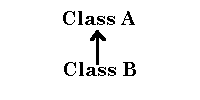
| Home : Course Map : Chapter 4 : Java : |
|
Method Overriding
|
| JavaTech |
| Course Map |
| Chapter 4 |
|
Introduction
|
| Supplements
Override/Overload Annotation-J2SE5.0 Java Security Class Loading Class Verifier SecurityManager |
| About
JavaTech Codes List Exercises Feedback References Resources Tips Topic Index Course Guide What's New |
|
A subclass may want to provide a new version of a method in the superclass. In fact, this is usually the whole reason for creating a subclass. When a subclass method matches in name and in the number and type of arguments to the method in the super-class (that is, the method signatures match), the subclass is said to override that method. In the code below, we see that subclass B overrides the method doSomething() in class A:
When we create an instance of class B, an invocation of the method doSomething() will result in a call to the doSomething() code in class B rather than A:
The real power of overriding, however, is illustrated by this code:
Here we see that even though the superclass type variable ab references the subclass object, the subclass's method will be executed rather than the superclass's overridden method. This is very useful when, for example, an array of the base class type contains references to various subclasses. Looping through the array and calling a method that is overriden will result in the method in the subclass being called rather than the method in the super-class. The following code illustrates this so-called polymorphic feature of object oriented languages:
It is important to understand that even though the array is of the subclass A, the code used for the doSomething() methods will be that of the actual object that is referenced, not the code for the doSomething() method in the A base class .
Latest update: Oct.24, 2004
|
|
Tech |
|
Physics |
